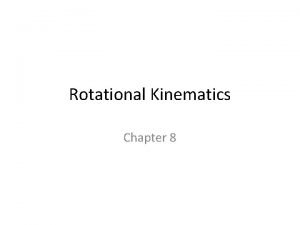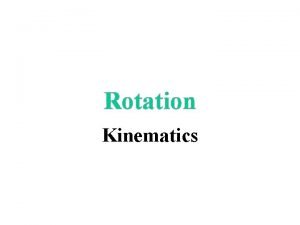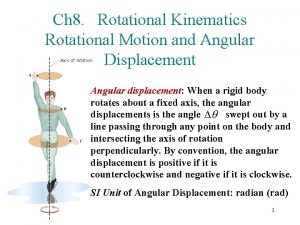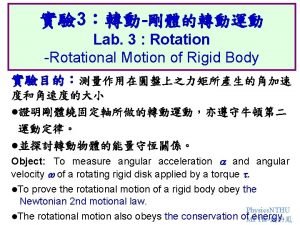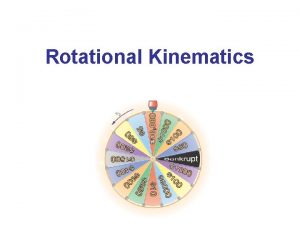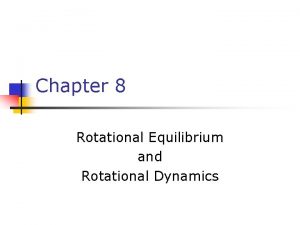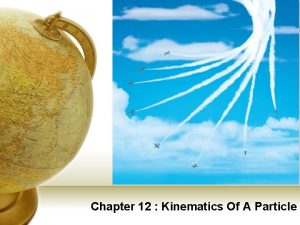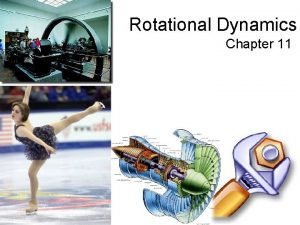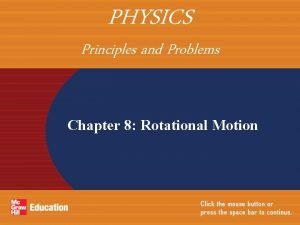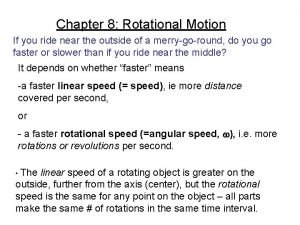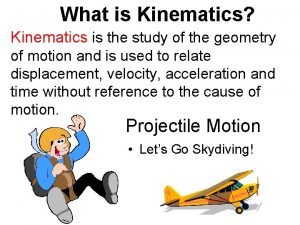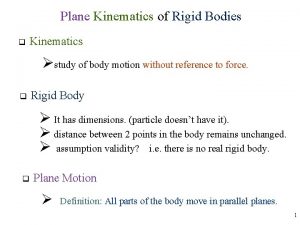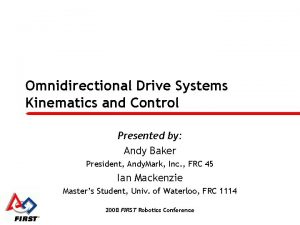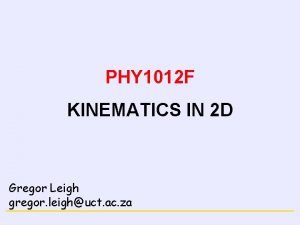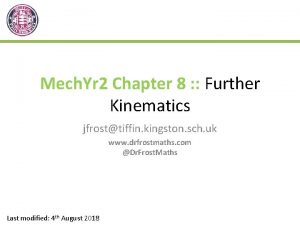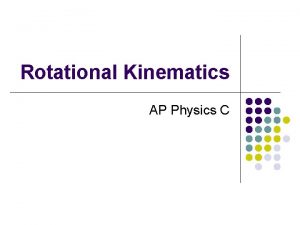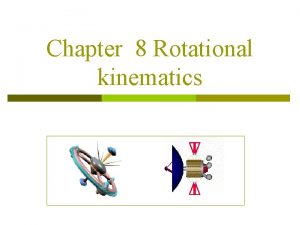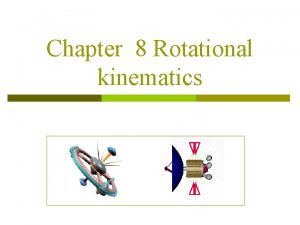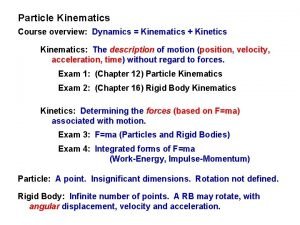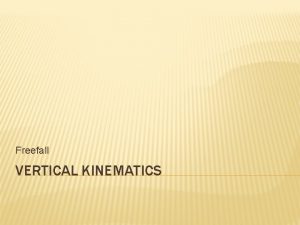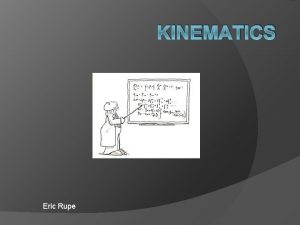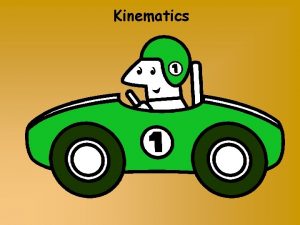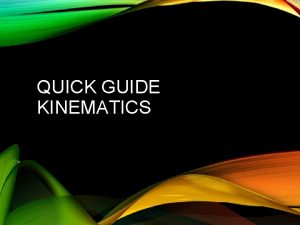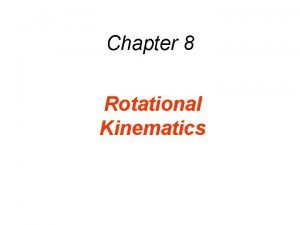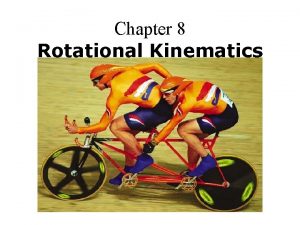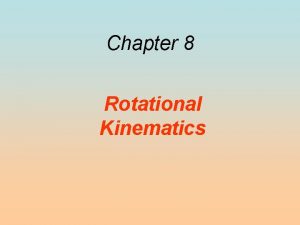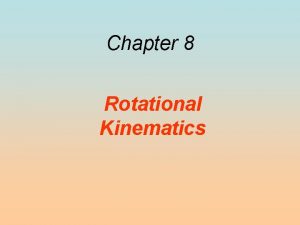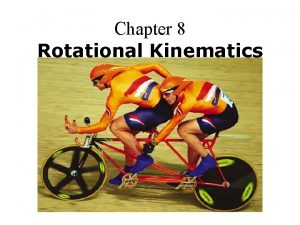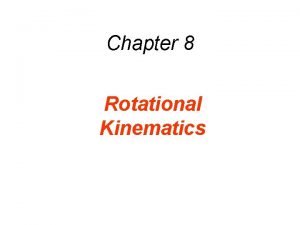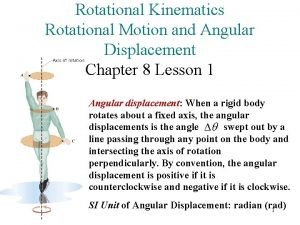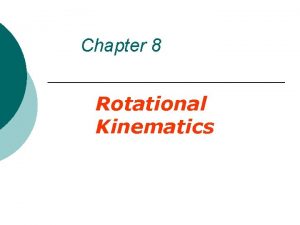Chapter 8 Rotational kinematics Section 8 1 Rotational



















- Slides: 19

Chapter 8 Rotational kinematics

Section 8 -1 Rotational motion The general motion of a rigid object will include both rotational and translational components. For example: The motion of a wheel on a moving bicycle; A wobbling football in flight is more complex case. Rotations with only one fixed point (定点转动) Rotations with fixed axis(定轴转动) pure rotation

Two definitions of a pure rotation: p p Every point of the body moves in a circular path. The centers of these circles must lie on a common straight line called the axis of rotation. Any reference line perpendicular to the axis (such as AB in Fig 8 -1) moves through the same angle in a given time interval. y p A z Fig 8 -1 B x

How many freedoms are needed to describe completely for a pure rotation? 1(R) How many for a rotation with only one fixed point? 3(R) In general the three-dimensional description of a rigid body requires six coordinates: three to locate the center of mass, two angles (such as latitude and longitude) to orient the axis of rotation, and one angle to describe rotations about the axis.

8 -2 The rotational variables 1. Angular displacement Fig 8 -4 shows a rod rotating about the z axis. Any point P on the rod will trace an arc of a circle. The angle is the angular position of the reference line AP with respect to the x axis. x Z A y P y A x Fig 8 -4

We choose the positive sense of the rotation to be counterclockwise(逆时针). (8 -1) where the s is the arc which the point P moves, and r is the radius (AP). At time the angular position is angular displacement of P is. , at is. The during

2. Angular velocity We define the average angular velocity as (8 -2) The instantaneous angular velocity is (8 -3) Is a vector quantity? The dimensions of inverse time ( units may be radians per second ( revolutions per second ( ). ); its ) or

3. Angular acceleration If the angular velocity of P is not constant, then the average angular acceleration is defined as (8 -4) The instantaneous angular acceleration is (8 -5) Its dimensions are inverse time squared ( ) and its units might be or.

8 -3 Rotational quantities as vectors Commutative addition law for any vectors: Can angular displacements satisfy corresponding formula? ? ? ? As example, we first rotate a book about x axis, followed by about z axis. But if we first rotate the book by about z axis and then by about x axis, the final positions of the book are different.

We conclude that an d so finite angular displacements cannot be represented as vector quantities. If the angular displacement are made infinitesimal, the order of the rotations no longer affects the final outcome: that is Hence can be represented as vectors.

Quantities defined in terms of infinitesimal angular displacements may also be vectors. For example, is a vector Z Positive direction Its direction is determined by a right handed system Angular acceleration is also a vector quantity. A P y x

8 -4 Rotation with constant angular acceleration For the rotational motion of a particle or a rigid body around a fixed axis (which we take to be z axis ), the simplest type of motion is that in which the angular acceleration is zero. The next simplest motion is constant. From Eq(8 -5), , we now integrate on the left from to and on the right from time 0 to time t,

We obtain And , . (8 -6) , integrate Eq. again, So which is similar to Eq(2 -28) , (8 -7)

Sample problem 8 -3 Starting from rest at time t=0, a grindstone ( 旋转研磨机)has a constant angular acceleration of 3. 2 rad/s 2. At t=0 the reference line AB is horizontal. Find (a) the angular displacement of the line AB and (b) the angular speed of the grindstone 2. 7 s later.

8 -5 Relationship between linear and angular variables When a rigid body rotates about a fixed axis, we have Z r=|AP| (8 -8) where s is the distance which the particle moves along the arc, the radius r is the perpendicular distance from the particle to the axis, and is the angle which the rigid body rotates through. A P O x y

(8 -8) p Differentiating both sides of Eq(8 -8) with respect to the time, and note that r is constant, we obtain (8 -9) Where speed . Speed: (Ch. 2) is the (tangential) linear

p Differentiating Eq(8 -9), then or (8 -10) Where is the magnitude of the tangential component of the acceleration. The radial (or centripetal) acceleration is (8 -11)

For rotations with fixed axis, we have: r=|AP| z A Notate them in vector style: ( P ) ) o x ( Fig 8 -11 y

Sample problem 8 -5 If the radius of the grindstone of Sample Problem 8 -3 is 0. 24 m, calculate (a) the linear or tangential speed of a point on the rim, (b) the tangential acceleration of a point on the rim, and (c) the radial acceleration of a point on the rim, at the end of 2. 7 s. (d) Repeat for a point halfway in from the rim-that is, at r=0. 12 m. At 2. 7 s, we have known: r=0. 24 m (d) are the same, r=0. 12 m
 Aplusphysics kinematics-horizontal kinematics
Aplusphysics kinematics-horizontal kinematics 4 linear motion equations
4 linear motion equations Angular kinematic variables
Angular kinematic variables Rotational kinematics
Rotational kinematics Rotational inertia unit
Rotational inertia unit Rotational kinematics equations
Rotational kinematics equations Torque right hand rule
Torque right hand rule Rotational equilibrium and rotational dynamics
Rotational equilibrium and rotational dynamics Kinematics of a particle
Kinematics of a particle Chapter 10 section 1 meiosis answer key
Chapter 10 section 1 meiosis answer key Chapter 11 rotational equilibrium
Chapter 11 rotational equilibrium Chapter 8 rotational motion study guide answer key
Chapter 8 rotational motion study guide answer key Chapter 8 rotational motion
Chapter 8 rotational motion Differential drive inverse kinematics
Differential drive inverse kinematics Kinematics is the study of
Kinematics is the study of Sin 37
Sin 37 Iczv
Iczv Holonomic drive
Holonomic drive Laws of kinematics
Laws of kinematics Dr frost further kinematics
Dr frost further kinematics

